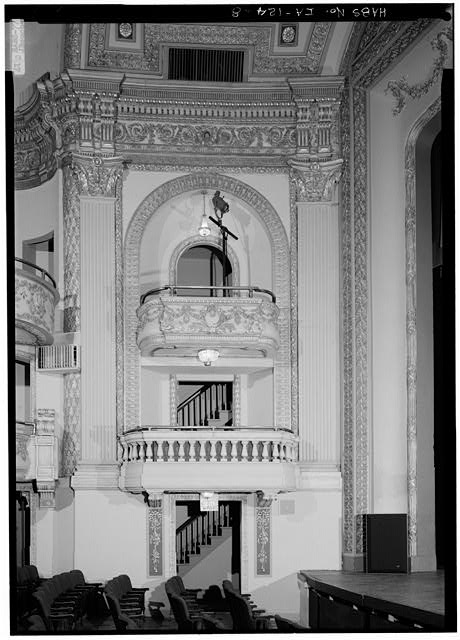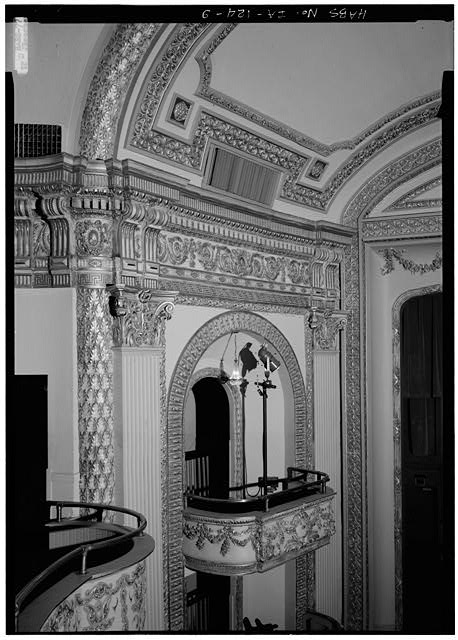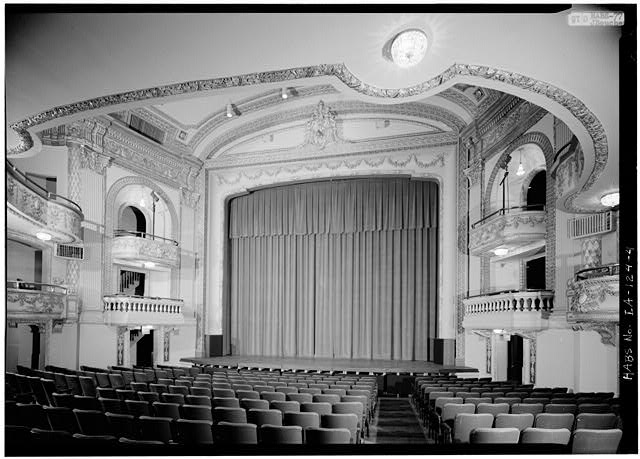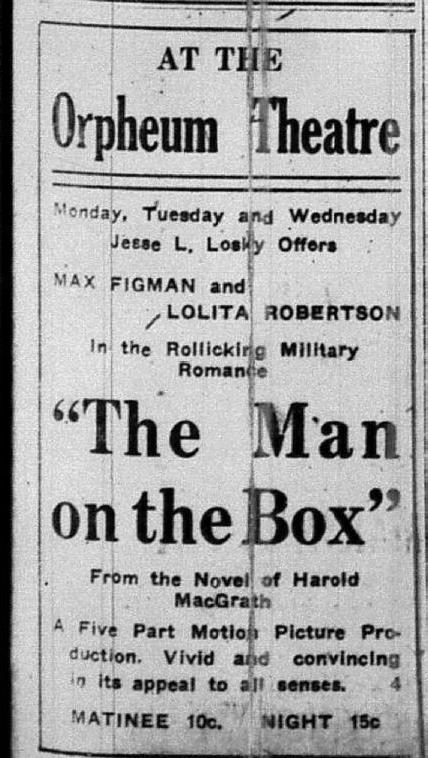Encyclopedia Dubuque
"Encyclopedia Dubuque is the online authority for all things Dubuque, written by the people who know the city best.”
Marshall Cohen—researcher and producer, CNN
Affiliated with the Local History Network of the State Historical Society of Iowa, and the Iowa Museum Association.
ORPHEUM: Difference between revisions
No edit summary |
No edit summary |
||
| Line 36: | Line 36: | ||
In 1969 the Orpheum along with much of the area around Lower Main Street was suffering disastrous economic times. The theater was scheduled for demolition as part of a fifteen-block [[URBAN RENEWAL]] project. | In 1969 the Orpheum along with much of the area around Lower Main Street was suffering disastrous economic times. The theater was scheduled for demolition as part of a fifteen-block [[URBAN RENEWAL]] project. There was consideration for razing the theater and constructing a comparable modern replacement until the financial and historical considerations were made. Razing the Orpheum, building a replacement theater was estimated to cost between $1,250,000 and $1,500,000. Renovation of the Orpheum and building a civic center was estimated then to cost $1.3 million. Historically, the Orpheum was located on a theater location since the [[ATHANAEUM]] in 1840. Architectural historian Denys Peter Myers of the federal Historic Buildings Survey had written: | ||
The building has great potential as a preservable example | |||
of its period. It is an ornament to the city and has an | |||
outstanding attractive interior. Most important, it has a | |||
potentially viable future as a theater and concert hall of | |||
historic importance in connection with the proposed civic | |||
center, since there is a large legitimate state and the | |||
acoustics are excellent. (1) | |||
Led by such community activists as [[NORMAN, Wayne Andrew Sr.|Wayne Andrew NORMAN, Sr.]], a group developed the idea that private donations could be collected to renovate the theater into part of an exhibition-arts facility. The project was named for the five national flags that have flown over this area. | |||
Led by Norman and representatives of the [[DUBUQUE CHAMBER OF COMMERCE]], U. S. Re. John Culver toured the Orpheum in October, 1971. By then the concept of restoring the theater and constructing a complete exhibition center adjoining it at 5th and Main had grown popular among local business leader and civic officials. Culver pledged he would look into the possibility of federal aid for the estimated $1.3 million project. Possibilities, he believed, lay in the Department of Housing and Urban Development and the National Preservation Act. (2) | |||
Hopes for financial assistance were dashed in April, 1974 when the Iowa Bicentennial Commission voted 12-8 to designate the Living History Farms near Des Moines as Iowa's official meeting house instead of Five Flags or the Old Capitol restoration project in Iowa City. This prevented Five Flags from receiving $1 million in federal funds. ( | A Five Flags Council comprised of 120 Dubuque civic leaders was announced in January, 1972. On February 29, 1972 the "Five Flags Spring Gala was held at the Orpheum. The event featuring the Roshek style show was used to kick-off the communityy teams division of the Five Flags Civic Center Campaign. A community-wide solicitation was begun in March. By December, 1972 Norman could announced that the fund drive had reached about 55% of its goal. Helping fundraising efforts was the designation that year of the [[ORPHEUM]] to the [[NATIONAL REGISTER OF HISTORIC PLACES]]. Sufficient resources had been gathered to plan in 1973 for the hiring of an architectural firm, make a bid for federal restoration funds, and seek federal money for the a multi-media exhibit. (3) | ||
Proposals to aid were presented to Iowa Governor Robert Ray; Murray Goodman, Iowa Director of the American Bicentennial Commission (ARBC); and Del Black, regional director of ARBC. Each endorsed the idea, but offered no money. In February, 1973 a delegation including Wayne Norman, Five Flags chairman; Mayor [[BITTER, Joseph|Joseph BITTER]], a county supervisor and 24 Five Flags committeemen flew to Washington, D.C. On their invitation list to see a presentation on the project were the entire Iowa congressional delegation, officials from Housing and Urban Development, representatives from the departments of Interior, Health, Education and Welfare, National Trust for Historic Preservation, ARBC, and the Bureau of Parks and Recreation. Their theme was a multi-media theater wold depict the development of the Upper Midwest and its importance to the nation beginning with the adventures of [[CARDINAL, Jean Marie|Jean Marie CARDINAL]]. According to their plan, the entire center in 1976 would be devoted to the bicentennial with frontier exhibits, multi-media theater, and perhaps a commissioned play. After that, the center would serve the tri-states. Their appeal was for $1.4 million--two-thirds of the $2.1 million need to refurbish the Orpheum and construct the civic center. (4) | |||
A smaller delegation presented the city's proposal to the Federal Regional Council meeting in Kansas City, Missouri in November, 1973. Helping the city was its recent designation as a national bicentennial city. Hopes were for part of $749,000 in federal funding. (5) | |||
Hopes for financial assistance were dashed in April, 1974 when the Iowa Bicentennial Commission voted 12-8 to designate the Living History Farms near Des Moines as Iowa's official meeting house instead of Five Flags or the Old Capitol restoration project in Iowa City. This prevented Five Flags from receiving $1 million in federal funds. (6) | |||
| Line 52: | Line 64: | ||
Source: | Source: | ||
1. "Culver Looks to Orpheum Aid," ''Telegraph-Herald'', October 31, 1971, p. 8 | 1. "Action Line," ''Telegraph-Herald'', March 10, 1972, p. 3 | ||
2. "Culver Looks to Orpheum Aid," ''Telegraph-Herald'', October 31, 1971, p. 8 | |||
3. "Chronology Section," ''Telegraph Herald,'' December 28, 1972, p. 20 | |||
4. Brimeyer, Jack. "Dubuquers to Push Five Flags Plan Tomorrow in Washington," ''Telegraph-Herald'', February 25, 1973, p. 12 | |||
5. "5 Flags Support Sought," ''Telegraph Herald'', November 15, 1973, p. 12 | |||
6. Miller, Jim. "Five Flags Loses Shot at $1 Million," ''Telegraph Herald'', April 29, 1974, p. 1 | |||
Revision as of 04:11, 25 January 2018
ORPHEUM THEATRE. In 1961 Nicholas J. YIANNIAS was assistant manager of ASSOCIATED THEATRES which included the Orpheum Theater, GRAND THEATRE, STATE THEATRE and STRAND THEATER.

In 1969 the Orpheum along with much of the area around Lower Main Street was suffering disastrous economic times. The theater was scheduled for demolition as part of a fifteen-block URBAN RENEWAL project. There was consideration for razing the theater and constructing a comparable modern replacement until the financial and historical considerations were made. Razing the Orpheum, building a replacement theater was estimated to cost between $1,250,000 and $1,500,000. Renovation of the Orpheum and building a civic center was estimated then to cost $1.3 million. Historically, the Orpheum was located on a theater location since the ATHANAEUM in 1840. Architectural historian Denys Peter Myers of the federal Historic Buildings Survey had written:
The building has great potential as a preservable example
of its period. It is an ornament to the city and has an
outstanding attractive interior. Most important, it has a
potentially viable future as a theater and concert hall of
historic importance in connection with the proposed civic
center, since there is a large legitimate state and the
acoustics are excellent. (1)
Led by such community activists as Wayne Andrew NORMAN, Sr., a group developed the idea that private donations could be collected to renovate the theater into part of an exhibition-arts facility. The project was named for the five national flags that have flown over this area.
Led by Norman and representatives of the DUBUQUE CHAMBER OF COMMERCE, U. S. Re. John Culver toured the Orpheum in October, 1971. By then the concept of restoring the theater and constructing a complete exhibition center adjoining it at 5th and Main had grown popular among local business leader and civic officials. Culver pledged he would look into the possibility of federal aid for the estimated $1.3 million project. Possibilities, he believed, lay in the Department of Housing and Urban Development and the National Preservation Act. (2)
A Five Flags Council comprised of 120 Dubuque civic leaders was announced in January, 1972. On February 29, 1972 the "Five Flags Spring Gala was held at the Orpheum. The event featuring the Roshek style show was used to kick-off the communityy teams division of the Five Flags Civic Center Campaign. A community-wide solicitation was begun in March. By December, 1972 Norman could announced that the fund drive had reached about 55% of its goal. Helping fundraising efforts was the designation that year of the ORPHEUM to the NATIONAL REGISTER OF HISTORIC PLACES. Sufficient resources had been gathered to plan in 1973 for the hiring of an architectural firm, make a bid for federal restoration funds, and seek federal money for the a multi-media exhibit. (3)
Proposals to aid were presented to Iowa Governor Robert Ray; Murray Goodman, Iowa Director of the American Bicentennial Commission (ARBC); and Del Black, regional director of ARBC. Each endorsed the idea, but offered no money. In February, 1973 a delegation including Wayne Norman, Five Flags chairman; Mayor Joseph BITTER, a county supervisor and 24 Five Flags committeemen flew to Washington, D.C. On their invitation list to see a presentation on the project were the entire Iowa congressional delegation, officials from Housing and Urban Development, representatives from the departments of Interior, Health, Education and Welfare, National Trust for Historic Preservation, ARBC, and the Bureau of Parks and Recreation. Their theme was a multi-media theater wold depict the development of the Upper Midwest and its importance to the nation beginning with the adventures of Jean Marie CARDINAL. According to their plan, the entire center in 1976 would be devoted to the bicentennial with frontier exhibits, multi-media theater, and perhaps a commissioned play. After that, the center would serve the tri-states. Their appeal was for $1.4 million--two-thirds of the $2.1 million need to refurbish the Orpheum and construct the civic center. (4)
A smaller delegation presented the city's proposal to the Federal Regional Council meeting in Kansas City, Missouri in November, 1973. Helping the city was its recent designation as a national bicentennial city. Hopes were for part of $749,000 in federal funding. (5)
Hopes for financial assistance were dashed in April, 1974 when the Iowa Bicentennial Commission voted 12-8 to designate the Living History Farms near Des Moines as Iowa's official meeting house instead of Five Flags or the Old Capitol restoration project in Iowa City. This prevented Five Flags from receiving $1 million in federal funds. (6)
---
Source:
1. "Action Line," Telegraph-Herald, March 10, 1972, p. 3
2. "Culver Looks to Orpheum Aid," Telegraph-Herald, October 31, 1971, p. 8
3. "Chronology Section," Telegraph Herald, December 28, 1972, p. 20
4. Brimeyer, Jack. "Dubuquers to Push Five Flags Plan Tomorrow in Washington," Telegraph-Herald, February 25, 1973, p. 12
5. "5 Flags Support Sought," Telegraph Herald, November 15, 1973, p. 12
6. Miller, Jim. "Five Flags Loses Shot at $1 Million," Telegraph Herald, April 29, 1974, p. 1





